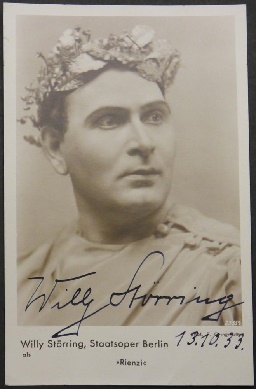Originally a blacksmith, Störring studied voice in Cologne and made also his debut there, as Manrico in 1927;
he stayed until 1930. Then in Düsseldorf for two seasons, and at the Berlin Staatsoper for the next three; in 1933 and
1934, he sang small roles at the Bayreuth Festival, and in 1935, in his usual heldentenor repertory, Rienzi at the Zoppot
Festival.
From 1936 to 1944, he sang in Weimar, plus one single guest performance at the Vienna Staatsoper (Radamès, 17 February 1940).
After World War II, he was a member of the Municipal Theater in his native Hagen from 1947. In 1952, he officially retired,
but in fact he returned to the Hagen theater as a guest until as late as 1972!
Störring left but four published sides (Telefunken, 1933). The two above are fantastic; the other two (an Aida medley in
two parts) are surprisingly disappointing in comparison, as far as he is concerned, and desirable only because of the
ladies: equally under-recorded Elsa Wieber, and awe-inspiring Margarete Klose.
Reference: Kutsch & Riemens
Picture source
